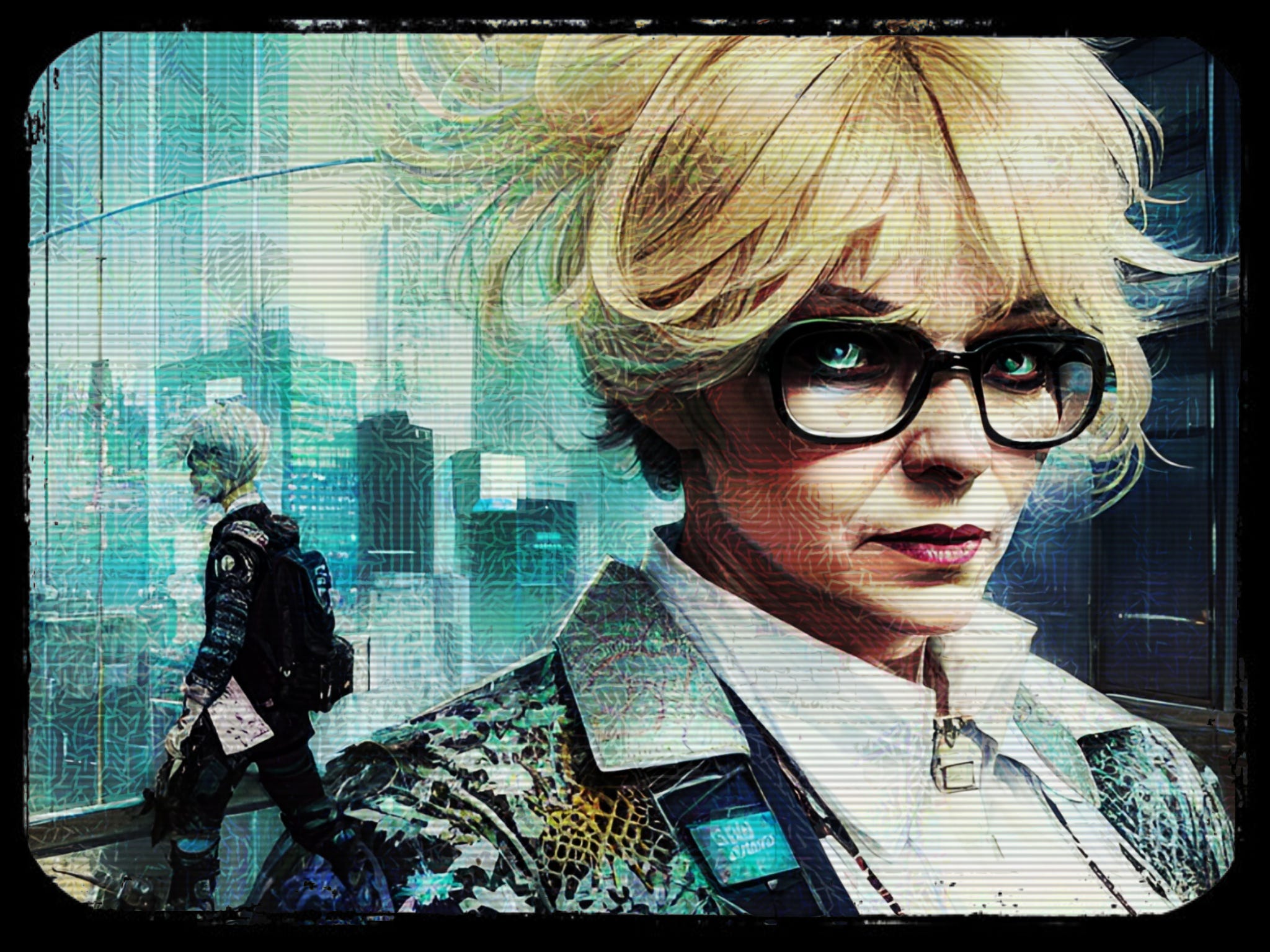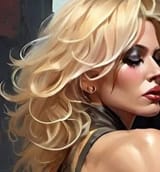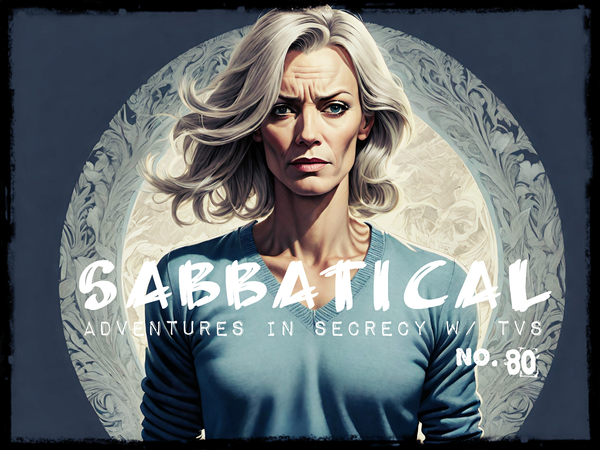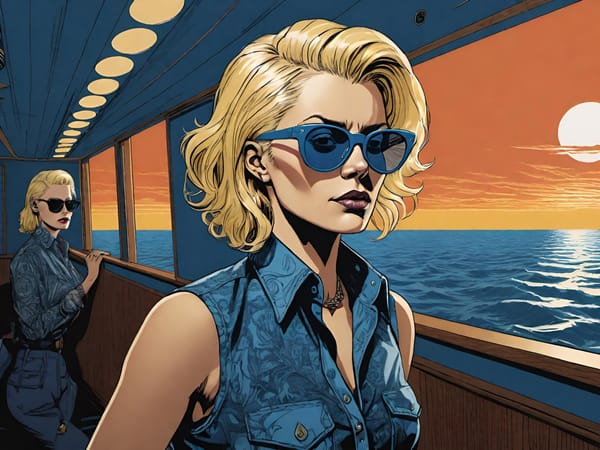My Mind, My Body: How They Fit Together & Come Apart
An alternate on-ramp for this novel
Please allow me to introduce myself …
I am Teresa Van Santana, and you are reading my latest novel, Teresa’s Backbone.
Here is a picture of me, looking very serious and writerly:

I started writing this beast last November as part of National Novel Writing Month and have continued on ever since, with a brief break to mourn the passing of my father, Wil.
The book is being serialized in the 21st Century, which is how and when you are likely receiving this, and so you may consider it a periodical, a work-in-progress, both, or anything else you wish.
You—that is, you the reader, the one who is reading this right now—are a character in this book, as well as in its predecessor, SOMA. Many installments—which we may call in roughly equal interchange chapters, bits, segments, fragments, pieces, or stories—have a section at the end called ‘play procedures.’ These contain instructions—well, no, wait a second … suggestions for further reflection on what you’ve read. There could be writing prompts. Or game information for a solo prole-playing game experience. Use them, change them, discard them, or ignore them as you will.
Each installment is part of one or more ‘story paths1’—a chain of story bits that form a more easily recognized storyline. There is not, as of yet, a definitive order in which to traverse these paths, nor is any one of them complete. Several of them tie into previous books, and some of them lead off into future books. Relax you mind as you walk them, and soon you will find that you understand more of what is going on than you might think. That’s the format.
Back to you. When I say that you are a character I mean you yourself. But that doesn’t mean you can’t play a fictional version of yourself. You are, after all, in a fictional novel. So be whoever or however you wish. And feel free to change some or all parts of yourself as you go, or to play again as someone new—a new you, I mean, for now, anyway2.
What follows below is an alternate starting point for the book. I started it almost a year ago, and have thankfully acquired many new readers since then, so it seems apt to offer a new on-ramp—or slip lane or entry ramp or acceleration lane or whatever the regional metaphor is for your time and place. It’s a new place to start reading.
I hope you enjoy it. You know how to read, so I won’t bother you about it, but if you have questions, please ask.
Xoxo,
T
I lower the book, then look at its cover. It’s not These Are the Things I Know. The title is: THE GRAND STORY OF … I can’t make out the last word. My mind fills with that sensation of near-knowing, what some say is on the tip of the tongue. But I can’t come to the meaning of the last word.
Frustrated, I snap the book closed and shove it into its place on the shelf, then stomp off on loud heels in quiet halls.
Along the way, my mind wanders. So, to be clear—or as clear as I can be—my body, or whatever seems to be my body, continues on its rage stomp. I am still ‘in’ it, dimly aware of my surroundings, of what is happening. But I’m largely not there, too—that is, my mind is unmoored and drifting free, like a spirit of sorts, but in a more ordinary fashion. You have experienced this before. It’s not an out of body thing. It is when your mind wanders, as it might when you are taking an angry walk alone. Which I was. Am. Whatever.
So it’s clear, then, that this is my mind I’m speaking of now. When I say ‘I’ here for the next bit (and I will let you know when it is over), I mean my mind, not my body. And the events that I am describing are happening in my mind, however it is that that happens. All right?
I am in the city of Soma. It is a city of my own design, my own making. It resides within my very cells—at least, I believe it does. If you could be there with me—and I have seen you there, so maybe you can be?—you would see it as a city, not terribly unlike one you know. I am addicted (in the popular sense) to 20th and 21st Century culture, so it looks like a town from the 1990s (or what I imagine such a town might have looked like). Many streets have cheeky names that suggest the city is in my brain—names like Myelin Avenue or North Corpus Callosum Street. Buildings, too, such as the Hippo Campus Hotel. I make jokes like that for myself in writing. Few folks get them, which is a bummer, but I smile when I read them, so it’s not a total loss. (Frankly, the Thirty-Second Century is a tough crowd. No one ‘has time’ for anything, so they miss a lot.) I’m certain I’ve romanticized the city, so you may want to, too. You know, for authenticity’s sake. It will get you closer to my experience, which is the main aim of any storyteller.
My ghost-like but totally not a ghost form feels real enough here, seems solid enough. And soon I completely forget that I’m only in my mind (to say nothing of the Library Eternal and wherever in hell that might be), and I think this is reality, this is where I live now. Here, in SOMA.
Here, in the city of Soma, I am separated from my partner and children. My partner is the somewhat famous filmmaker, Lila Juno, daughter of the rather famous musician, Presup Juno. We have two children: Mason and Fox. Mason is about seven; Fox is three. I think, anyway. Time is out of mind in Soma, and so I don’t really think about it, and I can’t recall how long I’ve been here.
I am separated from Lila, and I know it. But my kids … I’m certain I’ve seen them here in town. Well, Mason, anyway. I can’t recall seeing Foxie here.
My home—or place of residence, rather—is The Brubaker. It’s a sort of brownstone or bee and bee—an old hotel that is a tenement house now. It is vast, particularly when compared against what you might imagine looking at it from the outside. My room in the Brubaker is the Stiletto Room, wherein I live with my darlings, the literary equivalent of cats or caterpillars—furry things of which I am fond that keep me as an owner, rather me them as pets. My mind wants to linger a bit with them there, but it’s over.
And now that it is over, my mind returns to my body, still striding about the Library Eternal, no longer angry, and so my mind can be present in it, my body, again. I gain a fuller sense of place, my mind settling back into its seat in my body, wherever that actually is.
The slick black corridors have accustomed my eyes to softness. So when the bright light of a vestibule shines, I cringe. Just momentarily, but enough to recognize my eyes are not fancy here, in this place. The flesh that has been removed and upgraded, the neurosilicate strands I sewed in, are gone. Gone, or never were. I can’t tell a substantive difference, but on occasion—one such as this—will recall with a tiny start that I used to have them. Such awareness recedes faster than it arrives. So even though I am back in my body, it is not as I remember it, not fully.
The door from the vestibule to a collection room opens easily. If I touched a knob or button, I did not noticed. Inside, I click on tall heels to the third row, then turn down, search the shelves. Though I know the spines are all unique, they run together, a sort of tapestry sectioned off by mahogany slices—a rich mahogany, or something like it. My painted nails drag across them. The sensation does not arrive, but I’m not numb exactly either. This happens sometimes when my mind wanders, and it is accentuated here, in the Library.
I select a book. It leaves its place with a subtle sucking sound, a slide, a drag. Then, I fan the pages, taking in the smell. I feel no air on my face, but strands of hair loose in the front flutter. The smell is muted, but perceptible. The book looks old but smells new. Upon closer inspection, I can see that the volume is only made to look aged. I lower the book and glance at others, still shelved, and see that they are motley and variegated, some looking quite old, others new, many not so old but certainly not new. My curiosity ebbs, and I return to the book in my hand, my bracelets jangling as I raise it again.
The title is embossed. A deep red cover, rich and luscious, holds the words that name this thing. I cannot read them, at first, without my fancies to translate. I feel a surge of frustration. But I simply watch my feeling crest, then break, then wash away easily. Looking once more at the title, I see the symbols take shape as words I know. It reads: FANTASIES OF WEAKNESS.
I search the cover for a name—for the author’s name, I mean. There isn’t one, but on the spine there is an icon, a symbol, quite probably a publisher’s mark. It looks like a face with two hands covering the eyes and an open mouth. Though there is no indication illustrated directly that the face is crying, yet somehow that is evoked.
I am annoyed, and open the book, intending to search the front matter, but there is none. The inner cover is a prismatic chevron, stamped with the same symbol from the spine. There is no title page; the text begins straight away. And there is no chaptering that I can tell, no paragraphs, and little punctuation. None of the symbols are known to me.
With a sigh, I observe my frustration, like I did before. But this time nothing changes.
I close the book and shove it into my bag, knowing this is a useless gesture as I am unlikely to ever be able to read it, and there is little chance it will even still be in my bag when next I go to fetch it, should I ever recall its existence to begin with. One angry click after another carries me out of the collection room, through another vestibule, and back into the dark corridors where I feel most tranquil.
I feel my mind coming loose, again.

You can find a complete list of all published chapters within a chapter called “The Backbone.” ↩
There will be—but there is not yet—additional role-playing material whereby you can play premade characters who live and exist in the Secretsverse, but we are not there yet. ↩





